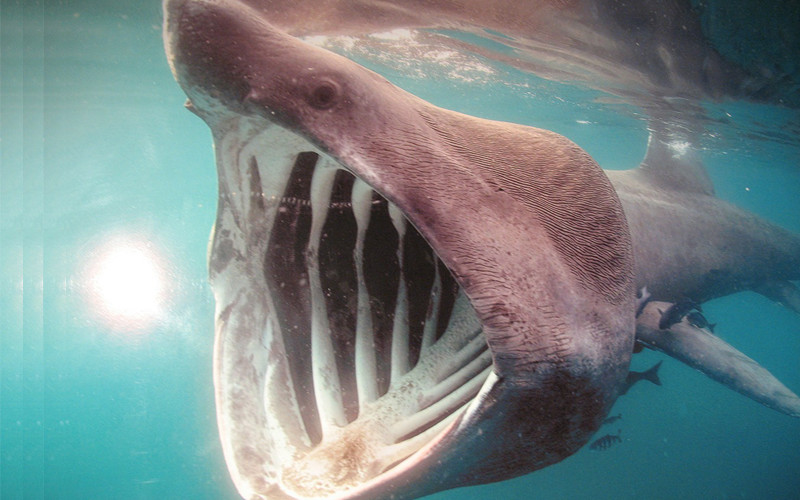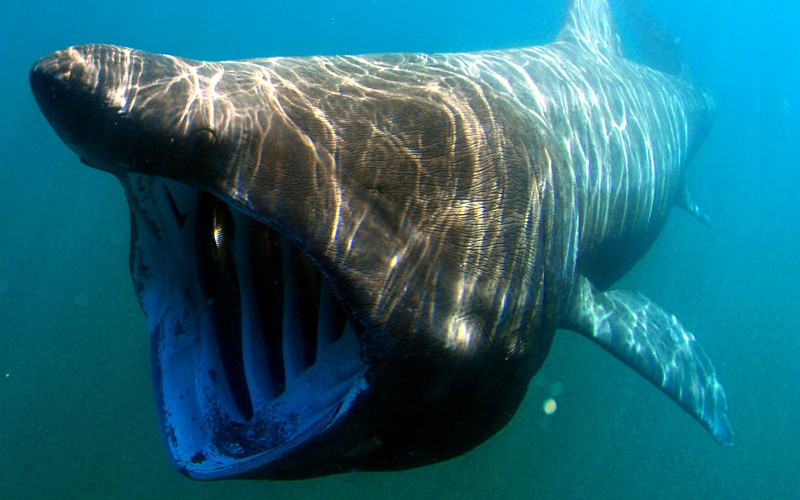Basking Shark – Cetorhinus maximus
The basking shark is the second largest shark in the world, only surpassed by the whale shark and, also, is one of the three planktivorous sharks. It is a “kind” shark for divers, despite its size and the impressive mouth that it possesses.
It belongs to the order Lamniformes, to the family Cetorhinidae and the genus Cetorhinus.
Description
The most impressive feature of the basking shark is its mouth, which opens up to 1 meter wide. It has a conical body covered with a layer of mucus, gray or brown skin on the back and white on the belly. Its dorsal and pectoral fins are so large that they can reach 2 meters each and its tail is crescent moon shaped.
It has a conical snout and large gills. Inside its mouth, this shark has several hook-shaped small teeth. Its liver is about 25 percent of its total body weight and is rich in squalene, a substance that helps the shark to float.
Its liver is about 25 percent of its total body weight.
Its weight ranges between 3,000 and 6,000 kilograms, and its length is around 6.7 and 8.8 meters.
Characteristics of the basking shark.
Basking shark – Cetorhinus maximus
Distribution and Habitat
The basking shark inhabits all oceans of the world, but it prefers the subpolar seas and in general cold and temperate waters of the continental shelves. It was recently discovered that it goes as far south as the equator and dwells into warmer waters.
Its habitat changes according to the food availability. In summer it goes to coastal areas to feed abundantly on copepods, but as soon as the winter begins, it migrates to cold water areas. Sometimes it gets close to the coast, and its great body is seen below the surface following concentrations of plankton near the surface.

Basking Shark – Cetorhinus maximus.
Feeding
Like the whale shark and the megamouth shark, the basking shark mainly feeds on plankton, so it is not a common predator. But unlike the other two species, it does not seem to actively seek for food or use the muscles of its head to suck water, instead, it usually swims with its mouth open and catches whatever it goes through. When the water passes through its gills, the spines of the gills rakers separate the plankton from the water. The shark closes the mouth and then pumps the water out through the gills.
The basking shark relies on the guidance of its large olfactory bulbs to detect food. It is a passive eater that can filter around 1,500-2,000 cubic meters of water per hour to obtain sufficient quantities of zooplankton, which also includes fish and small crustaceans, invertebrate animal larvae and fish eggs or larvae.
It feeds near the ocean surface, especially when plankton is abundant. Although it has hundreds of small teeth, it does not use them when feeding.
Behavior
The behavior of the basking shark is still unknown except for some information obtained from the observations. The motto of “basking” was got because it spends a long time feeding under the sun. One theory states that it prefers to feed in surface waters when there is abundant plankton in that part of the ocean, and at the same time it drops the spines of its gills. These are then renewed and so on, in a continuous seasonal process.
During the winter there are no sightings of basking sharks near the surface. Therefore scientists think that they migrate to deeper southern waters until the next summer. During this season many individuals are seen on the coasts of Iceland and northern Europe as they travel there to mate.
Its English name “basking shark,” means “taking the sun”.
The sturdy body and slow movements of the basking shark are not an impediment to jump out of the water trying to shed its parasites. It is also a relatively social animal because sometimes it forms small groups divided according to sex. Sometimes, they can form schools of up to 100 members.
Its English name “basking shark,” which means “taking the sun,” comes from its habit of swimming very close to the surface with the dorsal fin out of the water.
Reproductive Habits
The basking shark is ovoviviparous and reaches sexual maturity when it reaches a particular size; The male can reproduce if it already has a length of 1.5-1.8 meters and the female reaches sexual maturity when it has a length between 4 and 5 meters.
The type of reproduction, it is believed to be ovoviviparity. Fertilization is internal, and the embryos develop within the mother’s body in a yolk sac and without placental attachment. It is very likely that unborn babies practice oophagy.
Researchers are not yet sure of the length of the gestation period. The most accepted theory is that it lasts one year, but can be extended to 2 or 3 years. There is also no accurate knowledge about the number of offspring delivered, but once a pregnant female found had six developing pups inside, so perhaps the number is not very large. Once born, the little ones move away from the mother to start living on their own.
The basking shark gives birth only once every two to four years and its life expectancy is 50 years.
Threats and Conservation
The fishing of this shark has been very frequent for several centuries to obtain and to trade the meat, the oil, the liver, the cartilage and the fins. The oil, liver, and fins are still valued today, and this has caused serious problems for the survival of this shark that the IUCN Red List classifies it as a “Vulnerable” species.
For about 20 years, populations have drastically reduced and have not recovered yet. Fortunately, the situation put some countries on alert, and the species is now under protection in territorial waters of some countries like United States, United Kingdom, and New Zealand. Also, the commercial fishing of this species is banned in many regions.
Sources:
http://www.nefsc.noaa.gov/nefsc/Narragansett/sharks/basking.html
http://www.bbc.co.uk/education/guides/z94hvcw/revision
https://en.wikipedia.org/wiki/Basking_shark
http://www.iucnredlist.org/details/4292/0
http://www.arkive.org/basking-shark/cetorhinus-maximus/
https://www.flmnh.ufl.edu/fish/discover/species-profiles/cetorhinus-maximus
BioExpedition Publishing © 2017.

